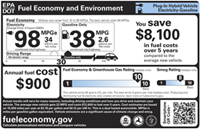ICCT Study Shows Plug-in Hybrid CO2 Emission Ratings Understated By 200-400%
 |
Editor's Note: I believe that the "blinded greenies" belief in EV fairy tales will soon be outed as bull...the total emissions from build to drive for EV's is higher than for ICE running on Flex-fuel without the limitations of electric. See Electric Vehicles Solution or Diversion?
Study Results: Analysis of plug-in hybrid electric passenger car data confirms real-world CO2 emissions are two to four times higher than official values
September 28, 2020 (Berlin) — A new analysis of the real-world usage of more than 100,000 plug-in hybrid electric vehicles shows a large deviation between on-road CO2 emissions and fuel efficiency and the official vehicle type-approval values. The results of the joint study, released by German Fraunhofer Institute for Systems and Innovation Research ISI and the International Council on Clean Transportation, suggest that incentives to promote a higher share of electric driving would increase the potential for plug-in hybrid vehicles to reduce emissions.
For the study, the authors analyzed a comprehensive dataset of the real-world usage patterns for plug-in hybrid vehicles in Europe, North America, and China. For their statistical analyses, the researchers made use of anonymized data that vehicle drivers had voluntarily reported to online portals such as Spritmonitor in Germany and MyMPG in the United States. The researchers also took into account data on company cars that had been provided by fleet managers.
Dr. Patrick Plötz, Coordinator of the Business Unit Energy Economy at Fraunhofer ISI and lead author of the study, summarizes one of the key results: "On average, the real-world fuel consumption and CO2 emission values of plug-in hybrid vehicles for private drivers in Germany are more than twice as high as according to the official test procedure. For company cars, the deviation is even four times the official values." As a result, the gap between official and real-world values is much larger for plug-in hybrid vehicles than for conventional combustion engine vehicles.
As plug-in hybrid vehicles are equipped with a combustion engine as well as an electric motor, their potential for reducing emissions depends strongly on daily driving patterns. Plug-in hybrid vehicles often are not recharged regularly, which implies driving is often performed on the combustion engine. Statistically, private users of vehicles in Germany re-charge their plug-in hybrid vehicle only on three out of four days. Company car users, on average, re-charge only every second day. The low frequency of recharging reduces the share of electric driving and thereby increases fuel consumption and CO2 emissions of plug-in hybrid vehicles in real-world driving. On average, private plug-in hybrid vehicles are driven only 37% of their mileage in electric mode; for company car vehicles it is only 20%.
The Fraunhofer ISI and ICCT researchers offer concrete recommendations from their analysis. The European Commission should update the testing procedures for plug-in hybrid vehicles and limit any credits as part of the EU CO2 regulation for new cars to those plug-in hybrid vehicles that demonstrate a high share of electric driving in real-world. ICCT Director Dr. Peter Mock suggests that "National governments should provide fiscal incentives only for those plug-in hybrid vehicle models that offer a high electric range and limit the power of the built-in combustion engine." Furthermore, any subsidies or reduced taxation rates should be tied to the vehicle owner demonstrating predominantly electric driving. Meanwhile, legal and financial barriers for installing home charging devices should be reduced.
Vehicle manufacturers should also take action: By increasing the electric range of plug-in hybrid vehicles from today’s average of 50 kilometers to 90 kilometers and limiting the power of the built-in combustion engine, manufacturers can provide an incentive for drivers to regularly re-charge their vehicles and to drive predominantly with electricity. Fleet managers should limit the available budget for petrol or diesel and instead offer employees the option to re-charge plug-in hybrid vehicles easily and at low cost. In doing so, the share of electric driving for plug-in hybrid vehicles could be increased.


